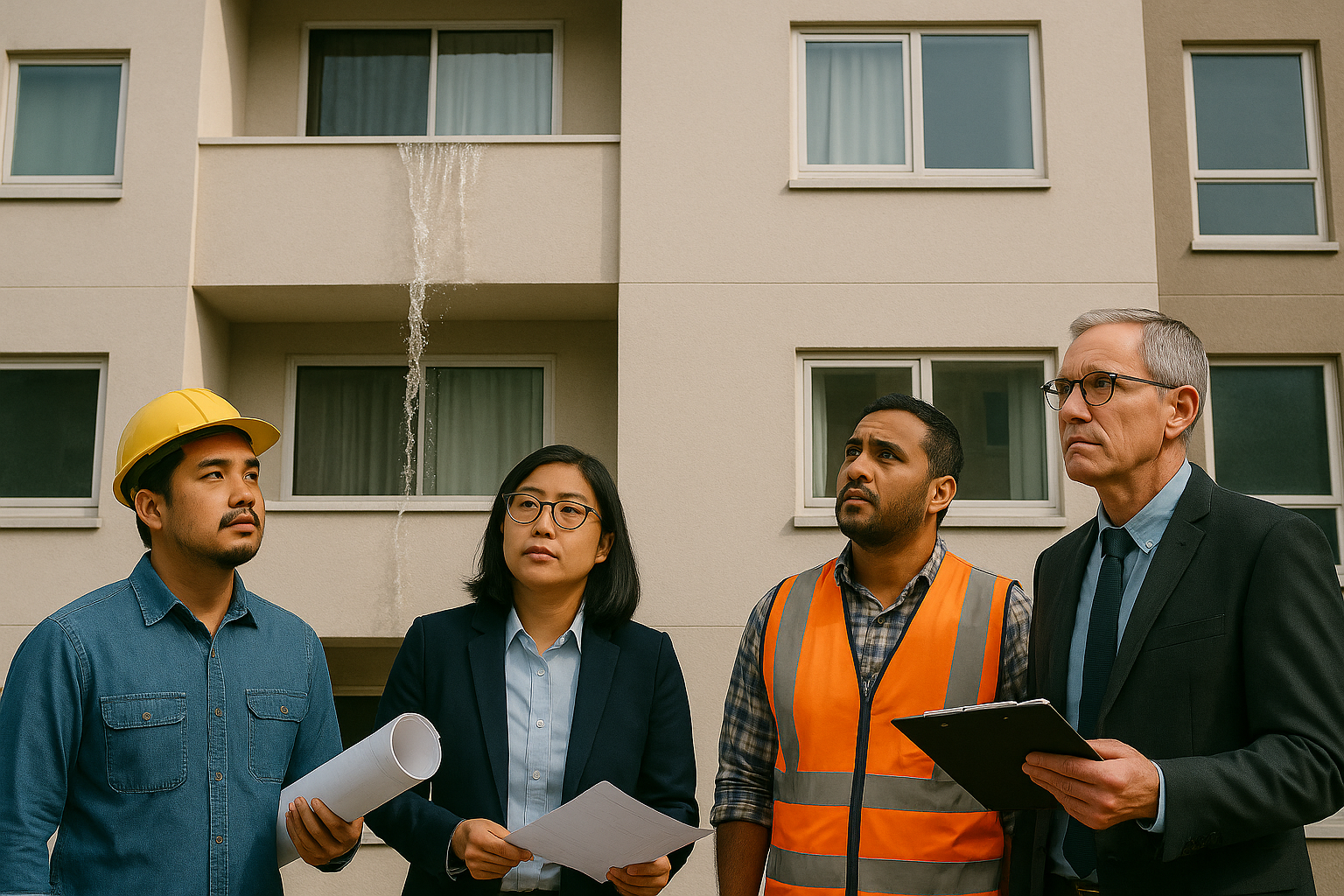
Liability for water that flows from one property and causes damage to another person’s property is an issue of increasing prevalence in Victoria, as apartment living becomes more common in the State. The owner of the property from which the water originates may be held liable for the resulting damage, whether the property is owned by a private individual or by an owners corporation, provided that the relevant legal test for liability is met.
In Victoria, the key legislative provision is section 16 of the Water Act 1989 (“the Act”) (“Vic), which reads as follows:
Section 16 of the Water Act 1989 – Liability arising out of the flow of water
“(1) If—
(a) there is a flow of water from the land of a person onto any other land; and
(b) that flow is not reasonable; and
(c) the water causes—
(i) injury to any other person; or
(ii) damage to the property (whether real or personal) of any other person; or
(iii) any other person to suffer economic loss—
the person who caused the flow is liable to pay damages to that other person in respect of that injury, damage or loss.”
“Flow” is defined in section 3 of the Act:
“’Flow’ in relation to water includes discharge, release, escape, percolation, seepage and passage, and includes both surface and underground flow”.
Section 20 of the Act sets out the factors for determining whether a flow is reasonable, having regard to all relevant circumstances, including the following matters:
“(1) In determining whether a flow of water is reasonable or not reasonable, account must be taken of all the circumstances including the following matters—
(a) whether or not the flow, or the act or works that caused the flow, was or were authorised;
(b) the extent to which any conditions or requirements imposed under this Act in relation to an authorisation were complied with;
(c) whether or not the flow conforms with any guidelines or principles published by the Minister with respect to the drainage of the area;
(d) whether or not account was taken at the relevant time of the likely impact of the flow on drainage in the area having regard to the information then reasonably available about the cumulative effects on drainage of works and activities in the area;
(e) the uses to which the lands concerned and any other lands in the vicinity are put;
(f) the contours of the lands concerned;
(g) whether the water which flowed was—
(i) brought onto the land from which it flowed; or
(ii) collected, stored or concentrated on that land; or
(iii) extracted from the ground on that land—
and if so, for what purpose and with what degree of care this was done;”
Whether a flow has occurred, and whether it is reasonable under the relevant provisions of the Act, is typically not contentious. However, determining the point at which ownership lies, particularly in relation to the property from which the damaging flow originates can be more complex.
Private and common property divisions
In Victoria, the Subdivision (Registrar’s Requirements) Regulations 2011 reg 10 prescribes how the boundaries between common and private property are determined, as follows:
“ (1) A boundary may be shown on a plan by reference to a building.
(2) Any building or part of a building that defines a boundary must be identifiable from the plan.
(3) If a boundary on a plan is defined by reference to a building or part of a building, the plan must specify whether the boundary is one or more of the following—
(a) Interior Face;
(b) Median (floor and ceiling);
(c) Median (wall, window, door, balustrade);
(d) Exterior Face;
(e) in some other location.
(4) Unless otherwise specified on the plan, the location of any building boundary defined as—
Interior Face lies along the interior face of any wall, floor (upper surface of elevated floor if any), ceiling (underside of suspended ceiling if any), window, door or balustrade of the relevant part of the building. Any internal coverings, waterproof membranes and fixtures attached to walls, floors, and ceilings are included within the relevant parcel;”
Balcony Leaks Causing Damage to Another’s Property

Balconies can present a more complex ownership issue, as the determination often hinges on the purpose and location of the building element that has failed and caused damage. In most cases, the failure relates to floor tiles or a compromised waterproofing membrane.
The question of ownership of balcony tiles and waterproofing membranes was directly addressed in Owners Corporation PS508732B v Fisher [2014] VCAT 1358. In that case, the Tribunal held that, for a conventional plan of subdivision, the waterproofing membrane fell within the boundaries of the individual lot. Accordingly, it was deemed private property and the responsibility of the lot owner.
Across most jurisdictions, there is little doubt that balcony floor tiles, particularly where issues such as lifting, cracking, drumming, or delamination are evident are similarly classified as private property in most cases.
By contrast, the structural slab beneath the balcony, which serves a purely functional, load-bearing purpose, is typically regarded as part of the common property infrastructure.
Obligations to Repair
Subsection 16(5) of the Water Act 1989 provides:
“(5) If the causing of, or the interference with, the flow (as the case requires) was given rise to by works constructed or any other act done or omitted to be done on any land at a time before the current occupier became the occupier of the land, the current occupier is liable to pay damages in respect of the injury, damage or loss if the current occupier has failed to take any steps reasonably available to prevent the causing of, or the interference with, the flow (as the case requires) being so given rise to.”
The key words here are “steps reasonably available.”
This provision was interpreted in Connors v Bodean International Pty Ltd (Real Property) [2008] VCAT 454 at [53], where the Tribunal stated:
“I find that ‘reasonable steps’ in the Act infers that the current occupier takes the necessary steps within a reasonable time… I would allow the Respondent a reasonable time to carry out investigations, assess the results and to implement measures to ensure the unreasonable flow is ceased.”
Two 2021 VCAT decisions have further clarified the obligation to take “reasonable steps.” In both cases, lot owners claimed compensation for water damage to their units, and liability was attributed to the Owners Corporations due to delay.
In Davies v Owners Corporation 1 PS414649K (Building and Property) [2019] VCAT 1159, the Applicants owned two apartments that were damaged by water entering through ceiling cavities into the living spaces. Evidence showed that the Owners Corporation had been aware of the leaks since at least 2008. The Tribunal, relying on Connors, found against the Owners Corporation and stated:
“… I consider that the words ‘steps reasonably available’ includes a requirement that the current occupier has a sufficient and reasonable time in which to carry out those steps after being given notice or constutive [sic] notice of the unreasonable flow is imputed. Further, that their liability in the event of them not taking reasonable steps to cease the flow after such notice is limited to the time from which such steps should reasonably have been taken.” [122]
In the matter of Dunn v Owners Corporation 446158A [2017] VCAT 1893, the Owners Corporation engaged a waterproofing contractor to carry out works recommended by a consulting engineer in early 2013. The contractor entered liquidation in early 2014, and the works remained incomplete due to a dispute over who was responsible for the rectification. The matter was ultimately heard in VCAT in late 2017.
Complicating the issue was the owner’s refusal to grant sufficient access for repairs. The owner indicated he would attend to the matter himself, after discovering an unknown gas pipe within the balcony slab, which further delayed remedial works. The Tribunal found:
“When deciding an owners corporation dispute, which is what is reflected in these two proceedings, the Tribunal must consider ‘the conduct of the parties’, but may make any order it considers fair, so long as it is made according to law… The conduct of both parties has contributed to delay, and so to exposure of unfinished works to the weather, and so in turn to the incurring of the costs identified in the previous paragraphs. Considering that conduct, I conclude that they contributed equally to it. Attempting to apportion responsibility in any other way would be artificial. So I consider it fair that each party should bear one-half of the cost.” [124]
Owners Corporation Responsibility
Under section 46 of the Owners Corporations Act 2006 (Vic), an owners corporation is responsible for the repair and maintenance of common property.
This obligation was examined in Guy v Owners Corporation 416326 [2018] VCAT 2027. In that case, the lot owner claimed that water had entered and damaged their apartment due to the owners corporation’s failure to maintain both the cladding façade and the owner’s balcony. While the precise source of the leak could not be definitively identified, the Tribunal found that the owners corporation’s failure to prevent water ingress into the lot was sufficient to justify an award of damages in favour of the owner.
The Tribunal stated:
“In view of the plethora of signs, warnings and portents which appeared before the OC with metronomic regularity throughout the life of the building, it is hard to see how the OC can assert that it is entitled to rely on section 16(5) of the Water Act 1989. It was clear, and the OC conceded, that it had notice of the possibility that water could flow from the façade into the applicant’s apartment.” [69]
Conclusion
It is essential that any property owner or owners corporation who becomes aware of a leak causing damage promptly seeks legal advice and acts on that advice without delay. Timely action is critical to mitigate damage and avoid potential liability.
By Lovegrove & Cotton
Disclaimer
This article is for general informational purposes only and does not constitute legal advice. For advice specific to Owners Corporations, building defects, or dispute resolution, please contact Lovegrove & Cotton at enquiries@lclawyers.com.au or call (03) 9600 4077.
Image Acknowledgements:
The digital renders used in this article were developed collaboratively by Lovegrove & Cotton and ChatGPT. The photo images that are not the digital renders are stock images sourced from Shutterstock.










